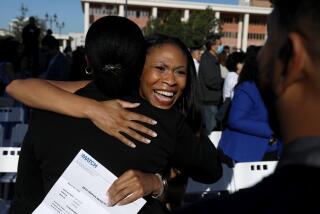More Women Seeing a Healthy Future in Medicine
Kirsten Mewaldt’s sense of idealism prodded her to apply to medical school. She sees practicing medicine as a way to serve humanity.
But Mewaldt, like many other women, also sees a big practical benefit to becoming a physician: With the changes in the profession in recent years, it has increasingly become an attractive career for someone who wants to balance work with raising children.
“One of the things that’s great about medicine is the flexibility,” said Mewaldt, a second-year medical student at USC, offering an opinion that defies the traditional reputation of a profession with little time for family life.
“I’m considering going into emergency medicine, and that has a wonderful lifestyle if you’re considering having a family,” she said. “You can do three 12-hour shifts a week, and then you’re not on call. You’re done. You can be home with your kids, pick them up from school and actually be around.”
That new image, medical educators say, helps explain why the profession has crossed a major threshold. The Washington, D.C.-based Assn. of American Medical Colleges reported last month that, for the first time on record, more women than men applied for admission to U.S. medical schools.
For this year’s freshman medical school classes, the association said, 50.8% of the 34,785 applicants were women. The percentage of female students enrolling in medical school was only slightly lower, at 49.7% of the 16,538 first-year students.
What’s more, mainly because of the increase in female applicants, the overall number seeking entry was up more than 3%, ending six straight previous years of declines.
Applicant totals locally and nationally remain far below the levels of the mid-1990s. Education officials say declining financial prospects for doctors, and the economic boom in the late 1990s that opened up lucrative opportunities in other fields, persuaded many potential candidates for medical school to look elsewhere.
Still, in recent years, female applicants have started picking up the slack, reflecting the growing number of women attending college and earning bachelor’s degrees.
Experts say the gender trend in medical school applications has also been aided by a shift in medicine over the last few decades from private to group practice, including health maintenance organizations. That enables doctors to share responsibilities and have more opportunity to work part time or to otherwise arrange family-friendly schedules.
For USC, too, the 2003-04 freshman medical school class was the first since the medical school was founded in 1885 to draw more women applicants than men. And nearly half, or 78, of the current 160 students enrolled in the first-year class are women.
Female applicants “just don’t feel the barriers anymore,” said Erin A. Quinn, associate dean for admissions at USC’s Keck School of Medicine.
Likewise, the school’s overall number of applicants, 4,656, marked a nearly 5% increase from the year before. The latest statistics for next year’s freshman class show that the overall number of applicants, and the percentage who are women, will be up once again. Nationally, the outlook is similar.
Job opportunities for female medical school graduates should be plentiful. Even with the influx of women physicians, various surveys have pointed to a doctor shortage developing over the next 20 years.
Although medicine isn’t the path to wealth that it once was, it remains a high-paying field. A survey by Medical Economics magazine found that U.S. doctors earned an average of $162,000 last year. Men averaged $180,000 and women $125,000.
That income gap stemmed at least partly from the lower-paying specialties in which female doctors are concentrated, such as internal medicine, obstetrics and gynecology, family practice and pediatrics. Women remain scarce in surgical fields.
Medical educators say many of their students, including the women, are less concerned about pay than previous generations of doctors.
For instance, Mewaldt, a graduate of Scripps College in Claremont, said she had friends “who graduated from college, went right into investment banking, and some of them were making six figures. It was, like, wow. But that never persuaded me. I knew I wanted to go into medicine more because I felt it was a calling.”
Applications from women are picking up at other Southern California medical schools too. UC Irvine’s medical school applications this year were up nearly 2% from the year before. Nearly all of the increase came among women, and this marked the second year in a row that female applicants outnumbered male.
At UCLA, the medical school application total fell this year nearly 2%, but the share of female applicants was the highest ever, 49.7%.
Another sign of the times: Nine of this year’s medical school seniors are women with children -- the most mothers ever in a UCLA medical school graduating class.
“Women have decided there’s no reason you can’t have families while you’re in medical school or after you graduate,” said Neil H. Parker, senior associate dean for student affairs and graduate medical education at UCLA. “Women who are in medicine are pushing the issue.”
The latest statistics also show that more blacks and Latinos are applying to medical school but, unlike with women, the percentage in these groups that enroll has dropped. As a result, some black and Latino female medical students at USC say they are concerned about the example they set for their own racial or ethnic communities.
“Even in [grade] schools, there aren’t a lot of black teachers,” said Glenda-Gayle Haskin, an African American student in her first year of medical school at USC. For many young black students, she said, “You really don’t know who to look up to. So, I thought I could be that person.”
One of her USC classmates, S. Nohemi Gonzalez, said she looks forward to serving other Latinos, particularly women. “I want my people out there to know there are Latina physicians who speak Spanish,” she said.
Meanwhile, women continue to lag in medical school faculties. According to the medical colleges association, only 13% of medical school faculty at the rank of full professor and only 10% of medical school department chairs are women.
Valarie Clark, associate director of women’s programs and faculty affairs for the association, said that stems from a tradition of American academic medicine that “has been all male and white.” Still, she said, “slow, steady progress” has begun in this area too.
More to Read
Sign up for Essential California
The most important California stories and recommendations in your inbox every morning.
You may occasionally receive promotional content from the Los Angeles Times.










